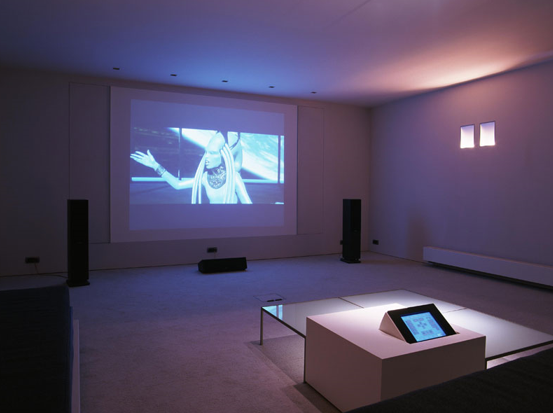home cinema
A home theater, home cinema, is a separate room for private cinema screenings. Equipped with appropriate equipment, home theaters, home cinema, can be used for sophisticated video performances with surround sound or for home entertainment. The quality of playback depends on many factors such as room size and equipment, surround sound system, presentation technology, projection technology and screen size, to name a few.
Home cinema takes place in a specially equipped room with appropriate acoustic properties. To avoid strong sound reflections from the walls, floor and ceiling, these are fitted with absorbent material or absorbers. The listeners' seats are located in the sweet spot. This position is chosen so that the sound from the loudspeakers can be heard optimally as surround sound and there is a good viewing angle to the large screen or the projectionscreen. The projection screen can be a motorized screen for the home cinema, which can be lowered into the ceiling or floor via a remote control.
Home cinema with stereo, surround and 3D sound
For good surround sound, home cinemas use Dolby Digital, Dolby Surround or Digital Theatre Sound( DTS), as 5.1 or 7.1, i.e. with five or seven loudspeaker boxes and a subwoofer. They are driven by low- distortion power amplifiers with rated outputs of 100 W and more. Further development is leading to 3D sound systems with ceiling speakers such as Dolby Atmos, DTS:X and Auro 3D, which will sooner or later be used in home cinemas.
Video and television in the home cinema
Home cinemas use the full range of television and video signals. For example, the classic television signal according to the PAL television standard, digital TV with high-definition television( HDTV) with 1,080 x 720 and 1,920 x 1,080 pixels, in 4K and in 5K standard, as well as in extremely high-definition Ultra-HDTV( UHDTV) with 8K. Satellite reception, the Internet and videos from DVDs or Blu-Ray discs( BD) serve as signal sources.
Home theaters can be equipped with large screens or projection technology. With projection technology, television and video projection is done with high- resolution projectors as front or rear projection on a projection surface. Decisive for the size of the projection screen are the luminous flux, the reference image brightness width(RHB) and the viewing angle of the viewer. High-brightness projectors such as Digital Light Processing( DLP), Liquid Crystal Display( LCD) and High Temperature Polysilicon( HTPS) are suitable for projection, with which the high-resolution TV and video signals can be shown on the displays or the projection screen. In projection technology, the gain factor of the projection surface plays a crucial role in the projected brightness. Therefore, the reflectivity factor of the projection surface should be between 0.8 and 1.1.
Transmission standards and interfaces
A home cinema has a satellite, digital or AV receiver or a set-top box for receiving digital TV and a BD player or DVD drive or else a hard disk for high-definition video and audio. The interfaces between the players, receivers and the displays or projectors must support data rates of many Gbps. For this purpose, there are Digital Video Interactive( DVI), HDMI interfaces and the DisplayPort in several versions. The latter supports net data rates of 25.9 Gbit/s. With WirelessHD and Wireless-HDMI, there are also wireless concepts for connecting the displays and projectors to the video source.
Another aspect is the connection cables between the individual devices, the projector and the speaker boxes. HDMI cables, cables for the TV and the sync signal, possibly a TOSlink cable and speaker cables for the speaker boxes and the subwoofer are used here.

